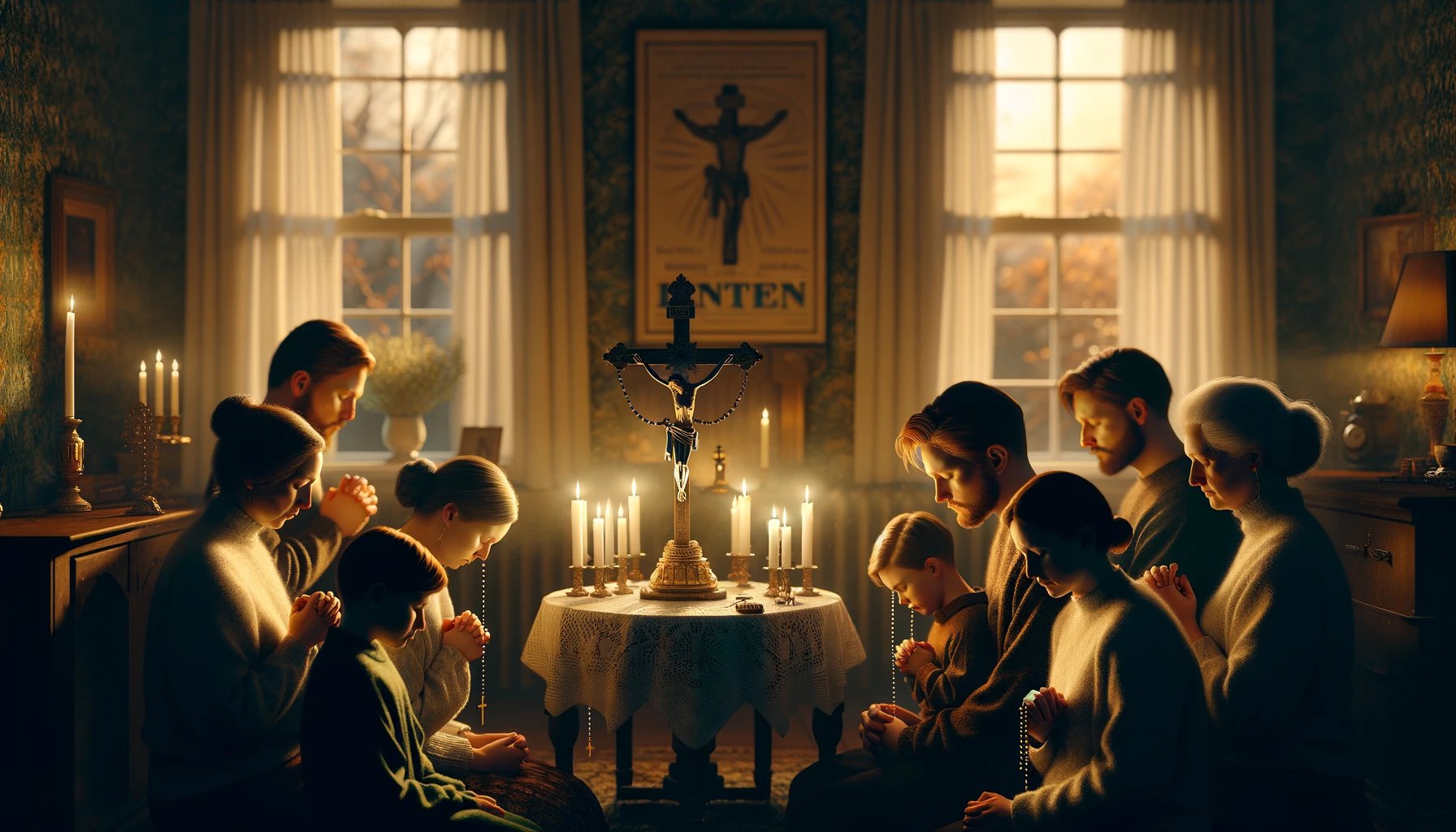Home>Special Themes>How Do Catholics Practice Lent?


Special Themes
How Do Catholics Practice Lent?
Published: February 27, 2024
Peter Smith, Editorial Director at Christian.net, combines deep insights into faith, politics, and culture to lead content creation that resonates widely. Awarded for his contributions to religious discourse, he previously headed a major organization for religious communicators, enhancing dialogue on faith's societal impacts.
Discover how Catholics observe Lent and its significance in their faith. Learn about the special themes and practices associated with this sacred season.
(Many of the links in this article redirect to a specific reviewed product. Your purchase of these products through affiliate links helps to generate commission for Christian.net, at no extra cost. Learn more)
Table of Contents
The History of Lent in the Catholic Church
Lent has been observed by the Catholic Church for centuries, with its origins dating back to the early days of Christianity. The word "Lent" itself comes from the Old English word "lencten," which means spring. The 40-day period of Lent mirrors the 40 days that Jesus spent fasting in the desert, as described in the Gospels of Matthew, Mark, and Luke. The practice of Lent as a period of fasting and preparation for Easter can be traced back to the early Church, where it was initially observed as a time of intense prayer and fasting for those preparing for baptism. Over time, Lent evolved into a season of repentance, self-examination, and spiritual discipline for all members of the Christian community.
-
Early Observance of Lent: The early Christians observed a period of fasting and preparation for Easter, but the duration varied from region to region. By the fourth century, there was a movement to standardize the Lenten period to 40 days, in imitation of Jesus' fasting in the wilderness. The Council of Nicaea in 325 AD played a significant role in formalizing the observance of Lent as a 40-day period.
-
Development of Lenten Practices: As the centuries passed, various Lenten practices and traditions emerged within the Catholic Church. These included fasting, abstinence from certain foods, intensified prayer, almsgiving, and the imposition of ashes on Ash Wednesday to symbolize repentance and mortality. The Lenten season became a time for Catholics to reflect on their lives, repent of their sins, and grow closer to God through acts of self-discipline and devotion.
-
Liturgical Changes and Emphasis on Spiritual Renewal: The Second Vatican Council in the 1960s brought about changes in the liturgical practices of the Catholic Church, including a renewed emphasis on the spiritual significance of Lent. The season was reaffirmed as a time for prayer, fasting, and almsgiving, as well as a period of spiritual renewal and preparation for the celebration of Easter.
-
Contemporary Observance of Lent: Today, Lent continues to be a significant and solemn period in the Catholic liturgical calendar. It is a time for Catholics to engage in acts of self-denial, prayer, and works of charity, as they prepare to commemorate the passion, death, and resurrection of Jesus Christ. The historical roots of Lent in the Catholic Church serve as a reminder of the enduring spiritual significance of this season for Catholics around the world.
Read more: How Do Catholics Fast During Lent?
The Spiritual Significance of Lent for Catholics
Lent holds profound spiritual significance for Catholics, serving as a period of introspection, repentance, and spiritual renewal. This season offers Catholics the opportunity to reflect on their relationship with God, examine their lives, and seek reconciliation with both God and others. The 40-day duration of Lent symbolizes the 40 days Jesus spent fasting in the wilderness, and it is a time for Catholics to follow His example by engaging in prayer, fasting, and acts of charity. The spiritual significance of Lent can be understood through its various aspects, each contributing to the overall spiritual growth and transformation of Catholics during this sacred season.
1. Preparation for Easter
Lent is a time of preparation for the celebration of Easter, the most significant event in the Christian calendar. By engaging in spiritual disciplines such as prayer, fasting, and almsgiving, Catholics prepare their hearts and minds to commemorate the passion, death, and resurrection of Jesus Christ. This period of preparation allows Catholics to enter into the Easter season with a renewed sense of faith, hope, and joy, having journeyed through a season of spiritual introspection and growth.
2. Self-Examination and Repentance
Lent provides Catholics with an opportunity for self-examination and repentance. Through prayer and reflection, Catholics are encouraged to examine their lives, identify areas in need of spiritual growth, and seek reconciliation with God and others. The sacrament of reconciliation, also known as confession, plays a significant role during Lent, as Catholics confess their sins and receive God's forgiveness, experiencing spiritual healing and renewal.
3. Spiritual Discipline and Self-Denial
The practice of fasting and abstaining from certain foods during Lent serves as a form of spiritual discipline and self-denial. By voluntarily giving up certain comforts or indulgences, Catholics are reminded of the importance of relying on God and cultivating self-discipline. This act of self-denial also fosters solidarity with the poor and those in need, as Catholics embrace a simpler lifestyle and redirect their focus towards spiritual nourishment.
Read more: Why Do Catholics Celebrate Lent?
4. Renewed Commitment to Prayer and Almsgiving
Lent encourages Catholics to deepen their commitment to prayer and almsgiving. Through increased prayer, Catholics seek to strengthen their relationship with God, draw closer to Him, and discern His will for their lives. Almsgiving, or acts of charity, allows Catholics to express love and compassion towards others, especially the marginalized and vulnerable in society. By engaging in acts of mercy and generosity, Catholics embody the spirit of Christ's love and selflessness.
5. Journey of Spiritual Transformation
Ultimately, Lent represents a journey of spiritual transformation for Catholics. It is a time to turn away from sin, embrace the grace of God, and grow in holiness. The spiritual significance of Lent lies in the opportunity it provides for Catholics to deepen their faith, cultivate virtues, and live more fully in accordance with the teachings of Jesus Christ. Through this season of spiritual growth and renewal, Catholics are invited to embrace the transformative power of God's love and grace in their lives.
In essence, the spiritual significance of Lent for Catholics encompasses a profound journey of faith, repentance, and spiritual renewal, culminating in the celebration of the resurrection of Jesus Christ at Easter. This sacred season serves as a reminder of the enduring grace and mercy of God, inviting Catholics to embrace a deeper relationship with Him and live as faithful disciples of Christ.
Fasting and Abstinence Practices During Lent
Fasting and abstinence are integral aspects of the Lenten observance for Catholics, representing a time of self-discipline, spiritual reflection, and solidarity with the suffering of Christ. These practices are rooted in the biblical and historical traditions of the Catholic Church and hold deep spiritual significance for believers during the Lenten season.
1. Fasting
Fasting during Lent involves the limitation of food intake, particularly by abstaining from meals or certain types of food. The traditional practice of fasting on Ash Wednesday and Good Friday, as well as abstaining from meat on Fridays throughout Lent, serves as a tangible reminder of the sacrifice of Jesus Christ. By voluntarily embracing hunger and physical discomfort, Catholics seek to unite their sufferings with those of Christ and enter into a deeper spiritual communion with Him.
Read more: What Are The Three Practices Of Lent?
2. Abstinence
Abstinence, particularly from meat, is another key practice during Lent. The tradition of abstaining from meat on Ash Wednesday and Fridays throughout Lent is a symbol of penance and self-denial. By refraining from the consumption of meat, Catholics express their willingness to make sacrifices and embrace a simpler, more austere way of life during this sacred season. This act of abstinence also fosters a sense of solidarity with those who experience hunger and deprivation, prompting Catholics to engage in acts of charity and compassion towards others.
3. Spiritual Significance
The fasting and abstinence practices during Lent carry profound spiritual significance for Catholics. These acts of self-discipline and self-denial are not merely external observances but are intended to foster internal spiritual growth and transformation. By embracing physical hunger and abstaining from certain comforts, Catholics are reminded of their dependence on God and the need to nourish their souls with spiritual sustenance. The practice of fasting and abstinence serves as a means of purifying the heart, cultivating virtues such as self-control and detachment, and drawing closer to God through acts of sacrifice and devotion.
4. Contemporary Observance
In contemporary times, the Catholic Church provides guidelines for fasting and abstinence during Lent, taking into account the age and health of individuals. While the traditional practices of fasting on Ash Wednesday and Good Friday, as well as abstaining from meat on Fridays, remain central, the Church encourages Catholics to approach these disciplines with a spirit of reverence and intentionality. The observance of fasting and abstinence during Lent is not simply a matter of adhering to rules but is an invitation to embrace a spirit of penitence, prayer, and solidarity with the suffering of Christ and humanity.
In essence, the fasting and abstinence practices during Lent serve as visible expressions of the spiritual journey that Catholics undertake during this sacred season. These practices are rooted in the rich traditions of the Catholic Church and continue to hold deep spiritual significance, inviting believers to embrace a spirit of self-discipline, sacrifice, and spiritual renewal as they prepare to commemorate the passion, death, and resurrection of Jesus Christ.
Prayer and Almsgiving in the Lenten Season
Prayer and almsgiving are fundamental components of the Lenten season for Catholics, representing acts of spiritual devotion, compassion, and solidarity with those in need. These practices hold deep significance in the spiritual journey of believers during Lent, fostering a spirit of prayerful reflection and charitable generosity as they prepare for the celebration of Easter.
1. Prayer
Prayer lies at the heart of the Lenten observance, serving as a means of deepening one's relationship with God, seeking spiritual guidance, and expressing gratitude for the gift of salvation. During Lent, Catholics are encouraged to engage in various forms of prayer, including personal prayer, communal worship, and participation in the liturgical life of the Church. The Lenten season provides an opportunity for Catholics to dedicate more time to prayer, allowing them to draw closer to God, discern His will, and cultivate a spirit of repentance and humility. Through prayer, believers seek to align their hearts and minds with the transformative grace of God, preparing themselves to embrace the joy of Easter with renewed faith and spiritual fervor.
2. Almsgiving
Almsgiving, or acts of charity, holds a central place in the Lenten observance, calling Catholics to express love, compassion, and generosity towards those in need. The practice of almsgiving during Lent encompasses various forms of charitable deeds, including giving to the poor, supporting humanitarian causes, and engaging in works of mercy and justice. By embracing a spirit of almsgiving, Catholics embody the teachings of Jesus Christ, who emphasized the importance of caring for the marginalized and vulnerable in society. Almsgiving during Lent serves as a tangible expression of love and solidarity, prompting believers to share their blessings with others and alleviate the suffering of those who are less fortunate. Through acts of charity, Catholics demonstrate their commitment to living out the Gospel values of compassion, justice, and mercy, thereby embodying the spirit of Christ's selfless love and concern for humanity.
3. Spiritual Significance
The practices of prayer and almsgiving during Lent carry profound spiritual significance for Catholics, shaping their journey of spiritual growth and renewal. Through prayer, believers seek to deepen their communion with God, open their hearts to His grace, and discern His presence in their lives. Prayer becomes a source of strength, solace, and spiritual nourishment, enabling Catholics to navigate the challenges of life with faith and hope. Almsgiving, on the other hand, becomes a tangible expression of love and solidarity, prompting believers to share their blessings with others and alleviate the suffering of those who are less fortunate. Through acts of charity, Catholics demonstrate their commitment to living out the Gospel values of compassion, justice, and mercy, thereby embodying the spirit of Christ's selfless love and concern for humanity.
4. Contemporary Observance
In contemporary times, the Catholic Church encourages believers to approach prayer and almsgiving during Lent with sincerity, intentionality, and a spirit of generosity. While the traditional practices of prayer and almsgiving remain central, the Church invites Catholics to embrace innovative ways of prayer and charitable outreach, utilizing modern resources and technology to foster spiritual growth and social solidarity. The Lenten season provides an opportunity for Catholics to engage in acts of prayer and almsgiving that reflect the diverse needs and challenges of the contemporary world, thereby embodying the timeless values of faith, compassion, and justice in a rapidly changing society.
In essence, prayer and almsgiving form the spiritual pillars of the Lenten season, inviting Catholics to deepen their relationship with God and extend compassionate care to those in need. These practices serve as transformative expressions of faith, love, and solidarity, shaping the hearts and minds of believers as they journey towards the celebration of the resurrection of Jesus Christ at Easter.
Read more: How Long Does Catholic Lent Last
Special Liturgical Practices and Observances During Lent
The Lenten season is marked by special liturgical practices and observances within the Catholic Church, each contributing to the spiritual richness and solemnity of this sacred period. These distinctive rituals and observances serve to immerse Catholics in a profound journey of faith, prayer, and contemplation as they prepare for the celebration of Easter.
1. Ash Wednesday
Ash Wednesday marks the beginning of Lent and is a day of solemn observance within the Catholic Church. It is characterized by the imposition of ashes on the foreheads of believers, with the minister reciting the words, "Remember that you are dust, and to dust you shall return." This ritual serves as a powerful symbol of human mortality, repentance, and the need for spiritual renewal. The ashes, derived from the burning of palm branches blessed on the previous Palm Sunday, remind Catholics of the transient nature of life and the call to turn away from sin and embrace the Gospel.
2. Stations of the Cross
The Stations of the Cross, also known as the Way of the Cross, are a series of 14 artistic representations or devotional stations depicting the events of Jesus' Passion and death. During Lent, Catholics participate in the devotion of the Stations of the Cross, retracing the steps of Jesus on the Via Dolorosa, the path to Calvary. This practice allows believers to meditate on the suffering and sacrifice of Christ, fostering a spirit of empathy, gratitude, and contemplation as they accompany Jesus on His journey to the Cross.
3. Lenten Fasting and Abstinence
The Lenten season calls Catholics to observe fasting and abstinence as acts of spiritual discipline and self-denial. In addition to the general practices of fasting and abstinence, the Church also emphasizes the observance of specific days such as Ash Wednesday and Good Friday as days of fasting and abstinence. These practices serve as tangible expressions of penance and solidarity with the suffering of Christ, inviting believers to embrace a simpler, more austere way of life during Lent.
4. Penitential Services
Penitential services, including the sacrament of reconciliation or confession, play a significant role in the Lenten observance. Catholics are encouraged to participate in penitential services, where they have the opportunity to confess their sins, seek spiritual guidance, and receive the sacrament of reconciliation. These services provide a space for believers to experience God's mercy and forgiveness, enabling them to embark on the journey of spiritual renewal and reconciliation with God and the community.
5. Triduum – Holy Thursday, Good Friday, and Holy Saturday
The Triduum, comprising Holy Thursday, Good Friday, and Holy Saturday, represents the culmination of the Lenten season and the beginning of the Easter celebration. These three days hold special liturgical significance, commemorating the Last Supper, the crucifixion and death of Jesus, and His descent into the realm of the dead. The liturgical observances during the Triduum, including the Mass of the Lord's Supper, the Veneration of the Cross, and the Easter Vigil, invite Catholics to enter deeply into the mystery of Christ's passion, death, and resurrection, preparing them to rejoice in the triumph of Easter.
In essence, the special liturgical practices and observances during Lent serve to immerse Catholics in the profound mysteries of the faith, inviting them to journey through the solemnity of Christ's suffering and sacrifice towards the joy of His resurrection. These rituals and observances form an integral part of the Lenten experience, shaping the spiritual landscape of believers as they prepare to embrace the hope and renewal of Easter.










